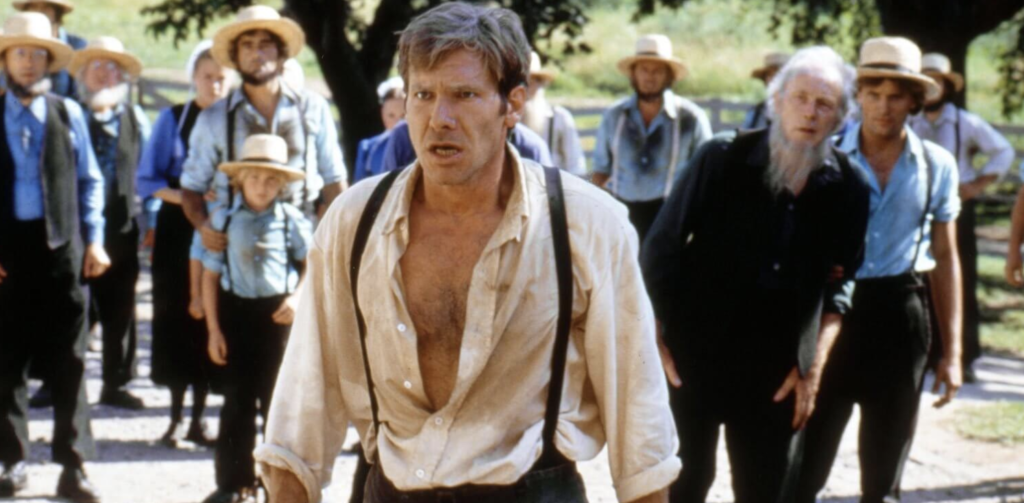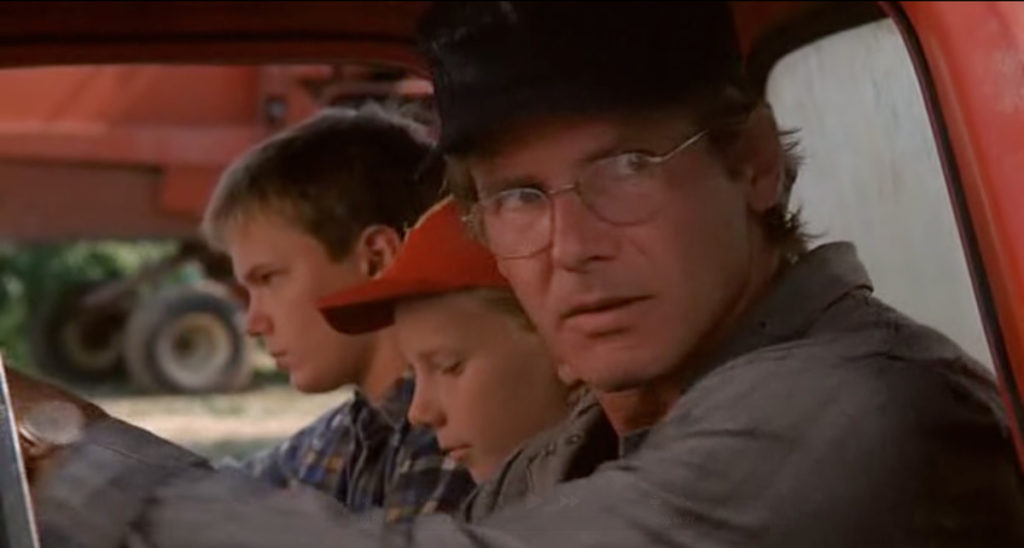| John Blair |

Witness plays at the Trylon Cinema from Friday, September 1st, through Sunday, September 3rd. Visit trylon.org for tickets and more information.
Coming off a nearly ten-year run that cemented him as an almost-accidental blockbuster star, Harrison Ford faced the question of all matinee idols who reach the top: What now? Instead of latching on to an established American auteur for a period piece or solemn historical epic, Ford found himself in the orbit of a leading member of the Australian New Wave—a film movement that previously explored the relationship between humans and the beautiful, dangerous, mystical, and unknowable natural world around them.
Working within and contributing to Weir’s vision in Witness and The Mosquito Coast, Ford created portraits of two men who, with opposing levels of intensity, find themselves confronted with two utopian alternatives to modern American society. The well-established screen presence Ford brings to each role impacts how we understand his characters’ relationship to the world as constructed by Weir and provides a framework the actor must work within as a performance baseline.

By 1984, Harrison Ford had been a key player in a string of blockbusters, starting with being a “why not” choice to play Han Solo in Star Wars.1 The Empire Strikes Back, Raiders of the Lost Ark, Return of the Jedi, and Indiana Jones and the Temple of Doom represent an iconic run of blockbusters that almost immediately cemented Ford’s persona as a movie star. Interviewed at Cannes as part of Witness’ debut at the festival, Ford stated, “It’s always been my ambition to do different sorts of films, play different characters. I’m not going to do another Star Wars film. That episode of my life is concluded.”2 Ahem…
Blade Runner, while now a cemented classic, is the only real interruption in this run, but points to a critical Fordian characterization and appetite that flows into both of his collaborations with Weir. By the time he was attached to Witness, Ford had established a solid screen persona: taciturn, skeptical, self-assured, and effortlessly physical. He was signed to the film before Weir, who focused the project more on a view into the world of the Amish of Lancaster County. Ford plays John Book, a Philadelphia police detective. We learn nearly nothing about him other than he has a sister played by Patti LuPone, whose presence suggests a version of Witness directed by Sidney Lumet.
Witness arrives at Ford through the Amish characters Samuel and Rachel Lapp, played by Lukas Haas and Kelly McGillis. Stranded in the Philadelphia train station, Samuel witnesses the murder of an undercover cop by other Philadelphia police officers McFee (Danny Glover) and Fergie (Angus MacInnes), who are part of an internal group of corrupt cops involved in the drug trade and thus necessitate Booth following them to Lancaster County to protect them.
Based on his actions and what others say about him, we know John is strong-willed. He stands outside of the Philadelphia police corruption ring, although his handling of potential suspects in early scenes suggests a short temper at best. Ford’s star persona fills in the gaps, allowing the audience to assume additional character traits that support the plot and emotional arc. Despite flashes of violence, we can assume he is fundamentally decent, mapping onto John our feelings about Han Solo and Indiana Jones.

Once the movie shifts to Amish country, Ford’s performance starts to weave more seamlessly into the film. Like Ford in real life, John has carpentry skills and arrives just in time to help with a barn raising. The question of exactly why John ended up as a detective in Philadelphia after working as a carpenter is brushed aside—this seems to make sense given the emotional zone Ford creates around his characters. The performance works from start to finish because the persona Ford had established meshes so entirely with what the character and film require of him.
The shift in locale is underlined by the filmmaking team’s immense skill in creating a mystical world a short drive from Philadelphia. They provide Ford with a backdrop to show an alternate destiny for John. This is not necessarily a fish-out-of-water story. One can see a version where Book doesn’t know which end of a pitchfork to use. The romantic tension between Ford and McGillis is as much about the lure of an alternate life more in tune with the natural world as it is about the lust and passion between the two characters.
John’s own actions signal his inability to truly leave the modern world behind. He is not romantically attached in Philadelphia, Rachel and the community are welcoming, and Samuel forms a bond with him. John’s intrinsic aggression begins the process of separation when he punches a local tourist who is harassing the Amish. This sets off events that reveal his location to McFee and Fergie, sending the plot toward its conclusion. The final silent moment between John and Rachel communicates an understanding that this scenario could never move forward considering the different worlds they come from.
Ford would team up again with Weir to play another character who finds himself in a utopia, this time through force of will and overt rejection of modernity. Weir signed on to direct Witness only after financing fell through on The Mosquito Coast, for which he was already scouting locations. During the filming of Witness, he discussed the project with Ford, who signed on and thus helped Weir obtain financing. Ford plays Allie Fox, an inventor/man of science who, as he tells us again and again, is disgusted by American commercialism and violence, uproots his family, and tries to create a utopia in a jungle village.

This is a big, extroverted performance. Everything Ford suggests with gestures and looks in Witness is spelled out in all caps in The Mosquito Coast. His dialogue in the opening sequence consists largely of declarative speeches decrying the state of 1980s America, decaying from consumerism and the laziness of thought and action Fox feels he alone can see and thus will escape by moving his family to Central America.
Ford’s performance is an interesting contradiction. It is a convincing, committed performance of a bloviating, self-righteous—and therefore, repellant—character. This doesn’t even take into account his actions toward his children and wife, who seem to raise no objections to his scheme. Ford performs at, one suspects, the peak of his abilities, making specific gestural and tonal choices that work to create a character that is combative both to the people around him and to an audience expecting the typical Ford performance. It is, however, a prime example of a screen persona being too strong for even a strong performance to overcome. Allie Fox was initially offered and turned down by Jack Nicholson. While unbelievable as someone who could conceivably construct even a chicken coop, Nicholson’s star persona—intense, questioning, prone to grandiosity—would have been a natural fit for the role on paper.
Ford’s performances in Witness and The Mosquito Coast are an extraordinary temporal and almost scientifically controlled model of what star presence can contribute to a movie. A filmmaker has 15-20 minutes to establish a character, and the correct casting can go far in ensuring those first minutes are maximized. There are one or two exceptions, but after the commercial and critical failure of The Mosquito Coast, which Ford took on against his agent’s advice, he moved back into the commercial mainstream with Working Girl, Indiana Jones and the Last Crusade, and took the role of Jack Ryan, contributing to another blockbuster franchise. Looking at his 40-year career from the vantage point of 2023, Ford’s two-film sojourn with Weir represents a unique break; an attempt to shape his stardom and create daylight between his persona and his abilities as a performer. That it didn’t fully work says less about Ford as an actor and more about the inherent qualities he brings. As with Marilyn Monroe, Humphrey Bogart, Katherine Hepburn, and contemporaries like Jack Nicholson and Jodie Foster, these qualities are a gift to the audience, but ultimately can burden a performer.
Footnotes
1 Sur, Debadrita. “The remarkable story of how Harrison Ford landed his role in ‘Star Wars.’” Far Out Magazine (November 16, 2020). https://faroutmagazine.co.uk/how-harrison-ford-landed-his-role-in-star-wars/
2 Kilday, Gregg. “Cannes Flashback: The Fest Bore ‘Witness’ to Harrison Ford’s Star Power.” The Hollywood Reporter (May 18, 2023). https://www.hollywoodreporter.com/movies/movie-news/cannes-flashback-harrison-ford-witness-1235493943/amp/
Edited by Olga Tchepikova-Treon
